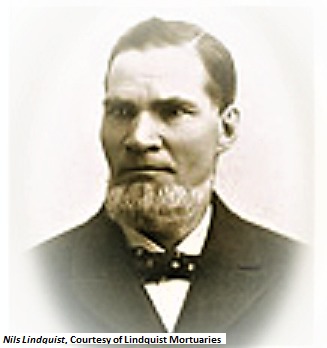Dublin Core
Title
Description
A Swedish immigrant went from furniture maker to undertaker in the Logan area during the 1800s.
Neils Lindquist was an accomplished cabinetmaker who converted to Mormonism and emigrated from Sweden to Salt Lake City in 1863. He built furniture in Salt Lake, and a bed he built is in the Beehive House today. Called by Brigham Young to help settle the Logan area in 1868, Lindquist set up a furniture shop that became the leading business of its kind in Cache Valley. It was difficult to get hardwoods in Utah, so most of the furniture in the territory was built of cedar, pine, and aspen, which affected design and use. Furniture legs made of soft woods had to be thicker than those of hardwoods to support the same weight, so Utah furniture had an awkward appearance. Lindquist’s furniture, however, though made of softwoods, was characterized by graceful lines. With the coming of the railroad to CacheValley in 1873, it suddenly became possible to import hardwood furniture from the east at a reasonable cost. In spite of Mormon leaders’ encouragement that members should only buy locally made goods, the rush to the more fashionable hardwoods was on.
Like most furniture makers and carpenters, Lindquist made coffins as part of his business. When the railroad came, he began selling imported furniture as well as his own, and the coffin business remained steady, so Lindquist changed the name of his business to N.A. Lindquist Furniture and Undertaking Goods. Eventually, the trend away from home manufactured furniture in favor of imported pieces took its toll. When the business passed to Lindquist’s son, Charles, he moved to Ogden and in 1885 turned the business entirely to coffin making and undertaking, founding the Lindquist Mortuaries, which still operate in Weber and Davis Counties today.
Consumers’ preference for imported furniture eventually put all local cabinetmakers out of business. Some switched to general carpentry and building, and some, like the Lindquists, found another profession that, at first blush may seem unrelated, but which was a logical transition for a cabinetmaker of the late nineteenth century.
Creator
Source
Image: Nils Lindquist. Mormon convert and Swedish immigrant, Lindquist was a cabinet and furniture maker by trade. Nils relocated his family to Logan, Utah, to make furniture and caskets. Courtesy of Lindquist Mortuaries.
_______________
National Register of Historic Places Nomination Form for Lindquist Hall, Statement of Significance, p. 1, Utah State Historical Society; “Nineteenth Century Cache Valley Folk Furniture: A Study of Form and Function,” by Elaine Thatcher (Thesis; Utah State University, 1983); http://www.lindquistmortuary.com/aboutus-history.html (September 12, 2007).

